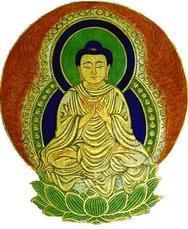
Resources
Who was Buddha?
What is Buddhism?
Where on land & net
When did Pure Land develop?
Why Jodo Shu?
How to be a Buddha
Daily Meditation
More Information

Who was Buddha?
What is Buddhism?
Where on land & net
When did Pure Land develop?
Why Jodo Shu?
How to be a Buddha
Daily Meditation
More Information
Buddhism is a path of practices and spiritual development which lead to insight into the true nature of life. Practices such as meditation are means of changing oneself in order to develop and perfect the qualities of awareness, kindness, and wisdom. The methods developed within the Buddhist tradition over thousands of years has created an incredible resource for all those who wish to follow the path which ultimately culminates in Enlightenment or Buddhahood.
The foundation of Buddhism is the Fourfold Noble Truth:
Because Buddhism does not include the idea of worshipping a God, some people do not describe it as a religion. The basic teachings of Buddhism are straightforward and practical: nothing is permanent; actions have consequences; but change is possible. Thus Buddhism addresses itself to all people irrespective of race, nationality, or gender. It also teaches practical methods such as meditation which enable people to make use of its teachings in order to transform their lives, to be fully responsible for those lives and to develop the desirable qualities of Wisdom and Compassion.
Buddhism began about 523 B.C.E., and the historical Buddha, Shakyamuni Buddha was a Hindu from northern India. His birthplace, Lumpini, is now part of Nepal. The "bible" of Buddhism is the "Tripitaka", or Three Baskets, formed of the Sutta (Sutras of the Buddha), Vinaya (precepts for the Sangha), and the Abhidhamma (higher teachings, or analytical writings about the higher states). The oldest extant manuscripts date to the first century B.C.E.
There are approximately 362 million buddhists in the world. There are many different forms of Buddhism, which developed and grew as it spread from India and Nepal throughout Asia. The three main vehicles are Theravada (sometimes known as Hinayana), Mahayana and Tantrayana (also known as Vajrayana). Theravada is the oldest tradition and is practiced predominently in Sri Lanka, Thailand, Burma, Cambodia, and Laos. Theravada practice has the goal of reaching the state of nirvana, becoming an arhat, and achieving liberation from the cycle of rebirth. Mahayana predominates in Northern India, China, Japan, and Vietnam. Tantrayana predominates in Tibet, Nepal, and Mongolia. Both Mahayana and Tantrayana practice is primarily to help all sentient beings reach enlightenment and in doing so achieve both nirvana and buddhahood. In Tantrayana additional tantric practices are used in order to achieve Buddhahood more quickly.